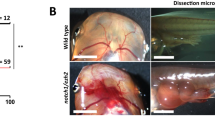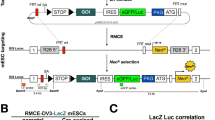Abstract
Mouse models have markedly improved our understanding of cancer development and tumor biology. However, these models have shown limited efficacy as tractable systems for unbiased genetic experimentation. Here, we report the adaptation of loss-of-function screening to mouse models of cancer. Specifically, we have been able to introduce a library of shRNAs into individual mice using transplantable Eμ-myc lymphoma cells. This approach has allowed us to screen nearly 1,000 genetic alterations in the context of a single tumor-bearing mouse. These experiments have identified a central role for regulators of actin dynamics and cell motility in lymphoma cell homeostasis in vivo. Validation experiments confirmed that these proteins represent bona fide lymphoma drug targets. Additionally, suppression of two of these targets, Rac2 and twinfilin, potentiated the action of the front-line chemotherapeutic vincristine, suggesting a critical relationship between cell motility and tumor relapse in hematopoietic malignancies.
This is a preview of subscription content, access via your institution
Access options
Subscribe to this journal
Receive 12 print issues and online access
$209.00 per year
only $17.42 per issue
Buy this article
- Purchase on Springer Link
- Instant access to full article PDF
Prices may be subject to local taxes which are calculated during checkout




Similar content being viewed by others
Accession codes
References
van Lohuizen, M. et al. Identification of cooperating oncogenes in E mu-myc transgenic mice by provirus tagging. Cell 65, 737–752 (1991).
Jonkers, J. & Berns, A. Retroviral insertional mutagenesis as a strategy to identify cancer genes. Biochim. Biophys. Acta 1287, 29–57 (1996).
Uren, A.G. et al. Large-scale mutagenesis in p19ARF- and p53-deficient mice identifies cancer genes and their collaborative networks. Cell 133, 727–741 (2008).
Dupuy, A.J., Akagi, K., Largaespada, D.A., Copeland, N.G. & Jenkins, N.A. Mammalian mutagenesis using a highly mobile somatic Sleeping Beauty transposon system. Nature 436, 221–226 (2005).
Collier, L.S., Carlson, C.M., Ravimohan, S., Dupuy, A.J. & Largaespada, D.A. Cancer gene discovery in solid tumours using transposon-based somatic mutagenesis in the mouse. Nature 436, 272–276 (2005).
Suzuki, T., Minehata, K., Akagi, K., Jenkins, N.A. & Copeland, N.G. Tumor suppressor gene identification using retroviral insertional mutagenesis in Blm-deficient mice. EMBO J. 25, 3422–3431 (2006).
Adams, J.M. et al. The c-myc oncogene driven by immunoglobulin enhancers induces lymphoid malignancy in transgenic mice. Nature 318, 533–538 (1985).
Hemann, M.T. et al. An epi-allelic series of p53 hypomorphs created by stable RNAi produces distinct tumor phenotypes in vivo. Nat. Genet. 33, 396–400 (2003).
Dickins, R.A. et al. Probing tumor phenotypes using stable and regulated synthetic microRNA precursors. Nat. Genet. 37, 1289–1295 (2005).
Zender, L. et al. An oncogenomics-based in vivo RNAi screen identifies tumor suppressors in liver cancer. Cell 135, 852–864 (2008).
Westbrook, T.F. et al. A genetic screen for candidate tumor suppressors identifies REST. Cell 121, 837–848 (2005).
Schlabach, M.R. et al. Cancer proliferation gene discovery through functional genomics. Science 319, 620–624 (2008).
Grueneberg, D.A. et al. Kinase requirements in human cells: IV. Differential kinase requirements in cervical and renal human tumor cell lines. Proc. Natl. Acad. Sci. USA 105, 16490–16495 (2008).
Firestein, R. et al. CDK8 is a colorectal cancer oncogene that regulates β-catenin activity. Nature 455, 547–551 (2008).
Luo, B. et al. Highly parallel identification of essential genes in cancer cells. Proc. Natl. Acad. Sci. USA 105, 20380–20385 (2008).
Ngo, V.N. et al. A loss-of-function RNA interference screen for molecular targets in cancer. Nature 441, 106–110 (2006).
Berns, K. et al. A large-scale RNAi screen in human cells identifies new components of the p53 pathway. Nature 428, 431–437 (2004).
Kelly, P.N., Dakic, A., Adams, J.M., Nutt, S.L. & Strasser, A. Tumor growth need not be driven by rare cancer stem cells. Science 317, 337 (2007).
Burgess, D.J. et al. Topoisomerase levels determine chemotherapy response in vitro and in vivo. Proc. Natl. Acad. Sci. USA 105, 9053–9058 (2008).
Burridge, K. & Wennerberg, K. Rho and Rac take center stage. Cell 116, 167–179 (2004).
Ridley, A.J., Paterson, H.F., Johnston, C.L., Diekmann, D. & Hall, A. The small GTP-binding protein rac regulates growth factor-induced membrane ruffling. Cell 70, 401–410 (1992).
Nishihara, H. et al. DOCK2 associates with CrkL and regulates Rac1 in human leukemia cell lines. Blood 100, 3968–3974 (2002).
Helfer, E. et al. Mammalian twinfilin sequesters ADP-G-actin and caps filament barbed ends: implications in motility. EMBO J. 25, 1184–1195 (2006).
Smith, L.G. & Li, R. Actin polymerization: riding the wave. Curr. Biol. 14, R109–R111 (2004).
Gao, Y., Dickerson, J.B., Guo, F., Zheng, J. & Zheng, Y. Rational design and characterization of a Rac GTPase-specific small molecule inhibitor. Proc. Natl. Acad. Sci. USA 101, 7618–7623 (2004).
Cancelas, J.A. et al. Rac GTPases differentially integrate signals regulating hematopoietic stem cell localization. Nat. Med. 11, 886–891 (2005).
Besson, A., Gurian-West, M., Schmidt, A., Hall, A. & Roberts, J.M. p27Kip1 modulates cell migration through the regulation of RhoA activation. Genes Dev. 18, 862–876 (2004).
Leask, A. & Abraham, D.J. All in the CCN family: essential matricellular signaling modulators emerge from the bunker. J. Cell Sci. 119, 4803–4810 (2006).
Nick, J.A. et al. Selective activation and functional significance of p38alpha mitogen-activated protein kinase in lipopolysaccharide-stimulated neutrophils. J. Clin. Invest. 103, 851–858 (1999).
Tani, N. et al. Effects of fibronectin cleaved by neuropsin on cell adhesion and migration. Neurosci. Res. 39, 247–251 (2001).
Kleber, S. et al. Yes and PI3K bind CD95 to signal invasion of glioblastoma. Cancer Cell 13, 235–248 (2008).
Margulies, M. et al. Genome sequencing in microfabricated high-density picolitre reactors. Nature 437, 376–380 (2005).
Acknowledgements
We would like to thank E. van Veen for help with motility assays, C. Whittaker and J. Pritchard for bioinformatic processing of sequencing data, H. Thompson for expert technical assistance, and members of the Hemann laboratory for helpful advice and discussions. M.T.H. is a Rita Allen Fellow and the Latham Family Career Development Assistant Professor of Biology and is supported by US National Institutes of Health RO1 CA128803-01. C.E.M. is supported by the MIT Department of Biology training grant, and E.E.H. and E.D. were supported by MIT's UROP program. Additional funding was provided by the Integrated Cancer Biology Program grant 1-U54-CA112967 to F.B.G. and M.T.H.
Author information
Authors and Affiliations
Contributions
C.E.M. and M.T.H. designed the experiments and wrote the manuscript. C.E.M. and E.E.H. performed the screen and subsequent validation experiments. E.D. and M.T.H. performed initial GFP dilution experiments. F.B.G. designed motility experiments.
Corresponding author
Supplementary information
Supplementary Text and Figures
Supplementary Figures 1–4 and Supplementary Tables 1 and 2 (PDF 1513 kb)
Supplementary Video 1
Suppression of Rac2 causes motility defects in lymphoma cells. Lymphoma cells were infected with a vector coexpressing a Rac2 shRNA and GFP (green), or a vector control that expresses the fluorescent protein Cherry (red). These cell populations were mixed and plated on fibronectin-coated plates, stimulated with SDF (100 ng/mL), and imaged for approximately 30 minutes. Representative cells are shown. In each movie, two unstained apoptotic (black) cells are also shown. (MOV 4876 kb)
Supplementary Video 2
Suppression of Rac2 causes motility defects in lymphoma cells. Lymphoma cells were infected with a vector coexpressing a Rac2 shRNA and GFP (green), or a vector control that expresses the fluorescent protein Cherry (red). These cell populations were mixed and plated on fibronectin-coated plates, stimulated with SDF (100 ng/mL), and imaged for approximately 30 minutes. Representative cells are shown. In each movie, two unstained apoptotic (black) cells are also shown. (MOV 4876 kb)
Rights and permissions
About this article
Cite this article
Meacham, C., Ho, E., Dubrovsky, E. et al. In vivo RNAi screening identifies regulators of actin dynamics as key determinants of lymphoma progression. Nat Genet 41, 1133–1137 (2009). https://doi.org/10.1038/ng.451
Received:
Accepted:
Published:
Issue Date:
DOI: https://doi.org/10.1038/ng.451
This article is cited by
-
Multicomponent regulation of actin barbed end assembly by twinfilin, formin and capping protein
Nature Communications (2023)
-
Twinfilin uncaps filament barbed ends to promote turnover of lamellipodial actin networks
Nature Cell Biology (2021)
-
Deficiency of Wiskott–Aldrich syndrome protein has opposing effect on the pro-oncogenic pathway activation in nonmalignant versus malignant lymphocytes
Oncogene (2021)
-
A quantitative shRNA screen identifies ATP1A1 as a gene that regulates cytotoxicity by aurilide B
Scientific Reports (2017)
-
NPM-ALK phosphorylates WASp Y102 and contributes to oncogenesis of anaplastic large cell lymphoma
Oncogene (2017)



